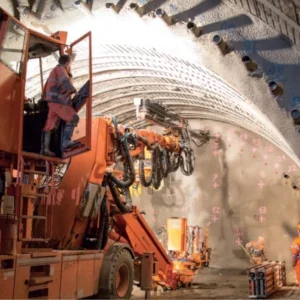During the 1990’s, pipe jacking in Asia was focused on Bangkok – to such an extent that it could have been described as the pipejacking centre of the world. In addition to a series of large sewer projects across the Greater Bangkok Area, pipejacking was used for high voltage electric cable and water transmission tunnels. The introduction of state of the art high technology solutions for automatic pipeline lubrication in order to achieve extremely low jacking pressures and sophisticated guidance systems were quickly adopted to achieve long distance pipejacks, often with curved alignments.
During recent years however, pipejacking work has slowed down to some extent in Bangkok with the Singapore Link Sewer Projects becoming dominant in the Asian market. Currently there are over 70km of tunnels being carried out by pipejacking in Singapore, in the range of pipe diameters from 400mm to 3m.
This has come about largely due to the Singapore Ministry of Environment Sewerage Department recognising one of the major advantages of a pipejacking solution, as opposed to segmental lining, in that concrete sewer pipes can be supplied complete with an inner protective HDPE lining; critical in preventing premature deterioration of the concrete sewer pipe in humid tropical conditions, and in so doing avoid the necessity of installing a secondary in situ concrete lining. Vitreous clayware jacking pipes, which do not deteriorate, are also popular in Singapore in diameters up to 800mm.
Whilst pipejacking has been carried out extensively in Singapore for over 25 years, up until recently it has been almost exclusively confined to short straight alignment drives. Unlike Bangkok, where the soft clay ground conditions are ideal for pipejacking, ground conditions in Singapore are extremely variable, ranging from soft marine clay to hard rock, and change rapidly with location. This has encouraged a more conservative approach in the use of pipejacking solutions.
The first curved pipejack in Singapore, which also was by far the longest driven to date on the island, was not completed until January 2004. The 591m long x 2400mm i.d. pipeline, forming part of a trunk sewer replacement on the Land Transport Authority’s Kalang/Paya Lebar Highway Project, was driven for over 400m on an 1800m radius horizontal curve, using a Herrenknecht EPB machine.
Similarly in Hong Kong, where major tunnelling projects have been undertaken for decades, the first major contract carried out almost exclusively by pipejacking was not until 1997. The hard granite rock conditions in Hong Kong in particular have secured the development of hard rock pipejacking machines. In 2002 a Herrenknecht AVN1800T machine on the Ap Lei Chau cable tunnel project successfully bored twin parallel 420m long pipelines in fresh granite with compressive strengths at times up to 400MPa.
Throughout Asia there are many recent examples of the adoption of long/curved pipejacks as preferred solutions to tunnelling schemes. Many of the projects now routinely being undertaken would have been considered too risky up until a few years ago, even in Europe. The following two projects have been selected from many.
Water transmission pipeline in Bangkok
Early in 2003 the Metropolitan Water Authority (MWA) of Bangkok awarded Contract PIT-711, for the supply and installation of trunk mains and related works, to Malaysian Contracting Group Salcon Engineering Berhad. The project, located in the Min Buri area on the North Eastern outskirts of Bangkok, included the installation of 7.1km of 1500mm i.d. composite steel pipeline by pipejacking along the busy Nimitmai Road. The construction of the shafts and pipeline was subcontracted to local pipejacking contractor IMC Engineering Ltd.
The steel pipe, designed and manufactured to MWA specification, comprises a 19mm thick inner steel lining separated by a 45mm thick annulus of cement mortar from a 6mm thick outer steel shell (Figure 1). The outer shell is set back approx 300mm at each end of a pipe to facilitate on site welding and x-ray testing of the inner pipe.
Continuity of the outer shell is secured by welding two semicircular makeup pieces across the joint after the inner pipe has been sealed and tested. The void between the linings at the pipejoints is filled with fibreglass insulation in place of mortar.
Whereas these pipes have previously been installed on MWA projects at a range of diameters by pipejacking method, simple hand tunnel shields have generally been used and little or no pipeline lubrication carried out in the soft Bangkok clay ground conditions. This has resulted in high jacking loads and a requirement for access shafts every 80m-100m. With pipelines mostly being located under roadways, the construction of numerous temporary works shafts invariably results in traffic chaos and environmental concerns.
The prospect of 7km of pipejacking along the ostensibly straight Nimitmai Road, lead IMC to use a remote controlled Herrenknecht EPB system with integral muck pump for transportation of the excavated soil via a 125mm diameter pipeline direct to the surface. Equipment was delivered to accommodate drive lengths of up to 600m.
The 75kW muck pumping system permitted the fastest possible removal of excavated soft marine clays by pumping directly from the screw conveyor mounted in the machine into a muck lorry.
To take full advantage of the high production rates that can be achieved by pumping the soft clays, a working shaft approx 24m long was set up to enable 18m (2m x 9m lengths) of steel pipe to be jacked without interruption. A target advance rate of 18m in 12hr was set. This period included the installation and 360º joint welding/testing of the 2m x 9m long pipes in the working shaft.
The photo to the right shows a working shaft straddling the central reservation of the Nimitmai Road. The shaft comprises interlocked heavy sheet piles and heavy strutting to contain the high lateral ground pressures. Welding of the pipejoints is nearing completion ready for the next 18m advance. The yellow control container for the tunnelling machine is set at the far end of the shaft with a full view of the jacking rig. The bentonite plant is adjacent to the control container under a tarpaulin shelter. A muck lorry is positioned under the muck line behind a 9m steel pipe section on the left hand side of the shaft.
The automatic pipeline lubrication system was provided with the tunnelling machine to maintain minimum jacking loads on the long drives. One injection station was installed every 18m, injecting bentonite lubricant through three specially drilled 20mm diameter ports set 120º radially in the steel pipewall.
As there was no possibility to have interjack stations in the fully welded and x-ray tested steel pipeline, it was essential to achieve minimum skin friction in order to achieve 600m drive lengths utilising only the 700t main jacking station in the launch shaft.
The objective of a 36m advance in 24hrs was met during the course of the first drive with average 24hrs daily advance established at circa 23m.
Excavation accounted for less than 25% of the overall working time with an 18m advance typically completed in 3.5hrs. Advance rates in excess of 200mm per minute were achieved in the soft clay enabling the 3500mm stroke of the jacking cylinders to be completed in under 20 minutes. One hour was required to remove the temporary spacers from the guide rails and install two more 9m long pipes ready for welding.
Two further similarly successful drives have since been completed since time of writing. Jacking loads have remained at an unprecedented low level throughout the three drives, even for the soft Bangkok clay soil conditions.
The frictional resistance of the pipeline during jacking is expressed as a coefficient, being the force in tonnes per square meter of pipe surface area required to advance the pipeline at any distance.
From Figure 2, which charts the jacking loads throughout the three completed drives, the average coefficient of friction can be seen to equate to 0.05. The loading on the second drive decreases some 30t, following the initial loading of face pressure on the machine during launch. Even including this initial loading the average coefficient of friction over this drive is 0.03, equating to a mere 50t jacking force at the 530m breakthrough point.
The exceptionally low levels of friction achieved on these drives has enabled the frequency of bentonite injection to be relaxed, although the site is well aware that the absence of full lubrication around the pipeline will, without doubt, result in a very rapid increase in jacking loads.
Trunk Sewer project on Hong Kong Island
The contract for the construction of the Wan Chai East and North Point Sewerage project was awarded to Leighton-Kumagai JV by Hong Kong Drainage Services Department in May 2002. The US$55M project is targeted for completion by December 2005 and at the time of writing the tunnelling works are approx 50% complete.
The project is for the upgrading of the existing trunk sewer system in the North Point and East Wanchai Districts of Hong Kong Island and includes for the construction of 3100m of 1800mm diameter, 800m of 1200mm diameter, and a short distance of 600mm diameter, concrete pipeline by pipejacking, at depths of up to 18m.
Ground conditions in the area are known to be extremely variable and include extensive tracts of reclamation (carried out in stages between 1863 and 1945) of indeterminable content. The underlying natural ground comprises beach and marine deposits, predominantly sand with some clay, over alluvium, decomposed granite, and at depth granite bedrock. The 1200mm drives have approximately 6m cover and lie predominantly in reclaimed materials, whereas the 1800mm drives, at around 18m depth, are in the natural ground strata. Three of the 1800 drives will be driven entirely within the hard granite bedrock.
The JV subcontracted the majority of the pipejacking works to local tunnelling contractor Fine Projects Ltd, but retained approx 50% of the 1800mm diameter pipeline to carry out themselves; commencing the first drive during May 2003 using a newly purchased Lovat 1800mm slurry machine.
Fine Projects Ltd purchased two slurry tunnelling machines from Herrenknecht, AVN1800T and AVN1200T. An AVN600 was also rented from Herrenknecht for the short section.
After the construction of the initial jacking pits, by the main contractor, Fine Projects commenced pipejacking with the AVN 1200T in July 2003, in the Causeway Bay area. Pipejacking was completed on this section of works during March 2004 with six drives, up to 150m long, being driven, including setting up site at four separate locations.
Core stones and parts of old seawalls were encountered in the drives and on two occasions, whilst cutting though grouted zones immediately above MRTC pedestrian subways, various steel obstructions (parts of temporary works construction) were successfully penetrated by the machine.
These drives also included sections of horizontal curved alignment, a first for Drainage Services Department and Hong Kong. An SLS-RV automatic system, supplied by VMT, was used to control the alignment on the 350m-750m radius curves.
The introduction of curved alignments by DSD tunnel consultants has also proven beneficial in giving greater flexibility of establishing both the sewer alignment and the positions of the permanent works manholes.
Despite the difficult ground conditions, the AVN1200 achieved perfect alignment throughout the curved alignments along Yee Wo Street. The average rate of advance over the six drives was 9m per shift.
The AVN 1800T was first launched in October 2003, since then it has completed a total of 800m of pipeline including a 220m drive in grade II granite. In this drive, advance was reduced to 5m per shift with three stoppages for cutter changes being necessary. A total of 14 cutters were changed overall. An average advance rate of 8m per shift has been achieved in the marine deposits.
The advance rates are not indicative of the potential rates achievable using the Herrenknechts. The speed of advance has on many occasions has been influenced by external factors, such as the limited access to working areas, small working sites, traffic congestion and environment concerns, particularly noise, brought about through the close proximity of residential and commercial properties. Night shift working was not permitted and production restricted to six shifts a week.
The Herrenknecht machine also outstripped the capacity of the separation plant when operating in the marine deposits, with no prospect of introducing additional/larger equipment owing to the small working sites. With virtually no muck storage facility, TBM advance was often delayed through muck trucks being caught up in local traffic congestion.
Progress on the Lovat drives had reached 480m in the 12-month period to May 2004. The machine is currently being fitted with a new cutting wheel at a mid-drive temporary shaft location and is expected to resume tunnelling in June 2004.
Completion of all pipejacking work is scheduled for January 2005.
Summary
The common factor in the projects described is the use of the automatic bentonite pipeline lubrication system to achieve extremely low coefficient of pipeline friction, subsequently negating the use of intermediate jacking stations, known to be both slow to operate and difficult to seal from leakage.
When curves are combined with long distances it becomes absolutely essential to have these low coefficients of friction to avoid damage at the pipejoints as they pass through the curved alignment when jacking loads are transmitted over a much reduced pipe end bearing area.
The upturn of this is long pipejacks, often with curved alignment, are now being easily achieved throughout Asia (in common with European projects) in the most demanding and variable ground conditions.
Related Files
Fig 1 – The steel pipe comprising a 19mm thick inner steel lining separated by a 45mm thick cement filled annulus and a 6mm thick outer shell
The curved alignments along Yee Wo Street in Hong Kong
Fig 2 – The jacking loads throughout the three drives on Bangkok’s water transmission pipeline Contract PIT-711






